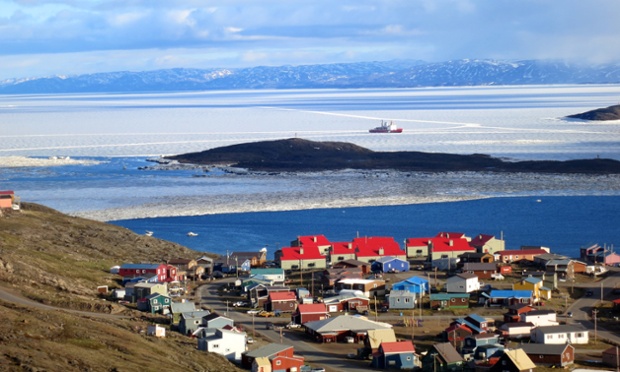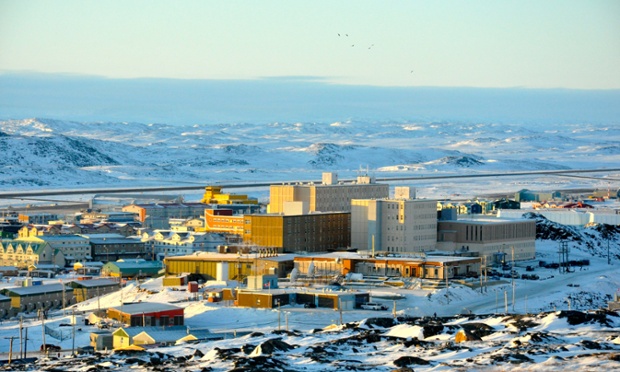Two radically different cities, and the sustainability challenges they face
Leading a sustainable life in Iqaluit and Johannesburg isn’t always easy, but communities are rallying to overcome long-standing hurdles

A Canadian Coast Guard vessel patrols during the spring thaw. Climate change means the shipping season is being extended. Photograph: Meagan Leach
Oliver Balch THE GUARDIAN
Sustainability is often seen as the preserve of the well-off. They are the ones that have the time and money to care about saving the planet. For everyone else, there are day-to-day concerns to worry about.
Yet it’s communities with very real social and environmental problems that arguably have the most to gain from sustainable solutions. Here, we look at two cities where, against the odds, efforts to promote sustainable living are emerging.
The first is Iqaluit, a remote indigenous community in the Canadian Arctic that is entirely reliant on imported diesel for power yet at the same time is seeing climate patterns impact its traditional ways of life. The second is Johannesburg in South Africa, where efforts to promote alternatives to private car ownership are slowly bearing fruit.
Iqaluit, Nunavut
Seven days (almost) living off-grid in London

Located in the far north-east of Canada, in Iqaluit average winter temperatures drop below –20C. The 8,000 or so residents rely entirely on diesel for power and on deliveries by air of perishable foods and almost all manufactured goods.
Yet last year saw the community – 60% of whom are indigenous Inuit – establish a sustainability plan that Mayor Mary Wilman hopes will help them remain “healthy happy, connected and prosperous” into the future.
One major preoccupation is food security. “What you would get from a farm, we get from the land,” says Wilman, referring to the Inuit tradition of subsistence hunting for fish, seals, whales and other wild animals. Yet climate change is leading to “very noticeable” alterations in weather patterns, she maintains. The result is a disruption to age-old hunting patterns.
A view of Iqaluit, with the airport runway in the background.
Tukisigiarvik Centre, a local non-profit, is seeking to address the problem by training younger generations in traditional hunting and survival techniques. It offers courses on everything from igloo-making and the manufacture of sealskin boots (called kamiik) through to the basic mechanics needed for snowmobile maintenance. “The climate is changing, but this lifestyle has sustained us for many, many years,” says Wilman.
One upside from the changing climate is the extension of the shipping season, which could in future see a new deep-water port built and a reduction in air freight.
Renewable energy represents another priority. Plans are afoot to install individual household electricity meters over the next 18 months, enabling residents who have solar panels to feed surplus energy into the grid. A proposal for the community’s first waste-to-energy facility has also been tabled.
What the experts say: how to make our cities more sustainable
Read more
For Robyn Campbell, the city government’s sustainability coordinator, the success of Iqaluit’s sustainable living objectives will be determined by three main factors: they must derive from the community as a whole; they must be centred on people; and they must reflect traditional knowledge (known as Inuit Qaujimajatuqangit).
“It’s about person-to-person relationships and person to environment relationships … and then deriving solutions that are creative, heartfelt and community-orientated,” she states.
Iqaluit’s summer boat launch area and breakwater.
Iqaluit’s summer boat launch area and breakwater. Photograph: Meagan Leach
Johannesburg
You need to be brave to live in Gauteng state. Home to Johannesburg, South Africa’s largest city, the state posted more than 6,000 carjackings, 3,300 murders, 1,300 kidnappings and 84,000 burglaries in 2013–14.
Unsurprisingly, residents in the state capital rate their fears of being mugged or having their car stolen as “very high”, according to a recent online poll. Walking the street at night, meanwhile, scores a measly 6.4 out of 100 (with 100 being very safe).
Such fears dissuade people from using public transport. As a consequence, an estimated 2m or more cars hit Johannesburg’s streets every day. Aside from the fossil fuel use, the city suffers almost perpetual traffic congestion.
In late 2013, the government of Gauteng put forward a 25-year integrated transport “master plan” (pdf). This proposed among other things better trains, more integrated bus routes and other road-based transport, and the “mainstreaming of non-motorised transport” such as cycling and walking.
Ten quirky ideas for making our cities more sustainable
Read more
The 80km-long Gautrain mass transit railway system, which connects the airport to the city centre, marks one public transport triumph of recent years. So too is the introduction of Rea Vaya rapid transit buses, which use dedicated roadways.
sustainable business.
Persuading people out of their cars will remain difficult while public safety risks are high. Innovations such as car sharing and ride sharing, for instance, are hamstrung by passenger fears about getting into a stranger’s vehicle.
Taxi service Uber is using smartphone technology to try and overcome such concerns. At the most basic, its 1,000 or so drivers in Johannesburg undergo a thorough criminal background check. In addition, the Uber app enables customers to rate them for politeness, safe driving and so forth. If the ratings are not acceptable, the driver is suspended, says Alon Lits, general manager for Uber in Johannesburg, Pretoria and Durban.
Uber has two main downsides: it’s relatively expensive, and it remains reliant on gas-guzzling passenger cars. Sharing an Uber taxi is one way of reducing the impact of both these factors, Lits says. This is an increasingly popular option among work colleagues, he notes. Another is mini-bus taxis, which have capacity to carry a dozen or more passengers and run on fixed routes around the city.
Realistically, cars will feature among Johannesburg’s transport mix for some time to come. As a taster of what a car-free city would look like, however, the business district of Sandton is trialling an “EcoMobility” month. This October, certain roads will be closed to private cars and turned into designated routes for walking, cycling and public transport.
The sustainable living hub is funded by Unilever. All content is editorially independent except for pieces labelled brought to you by. Find out more here.
Join the community of sustainability professionals and experts. Become a GSB member to get more stories like this direct to your inbox.
Topics







Follow Us!